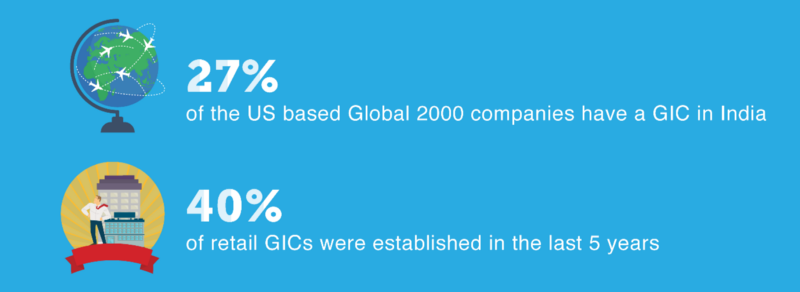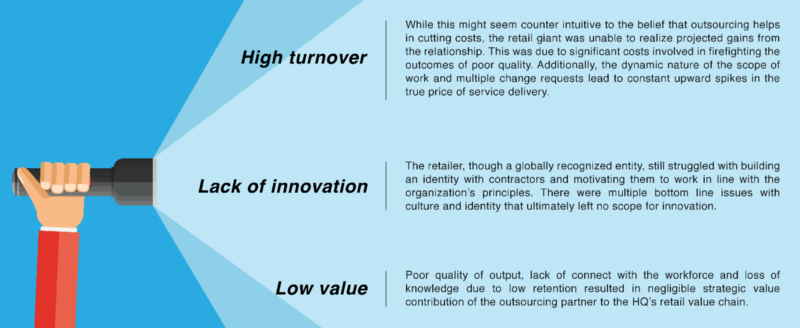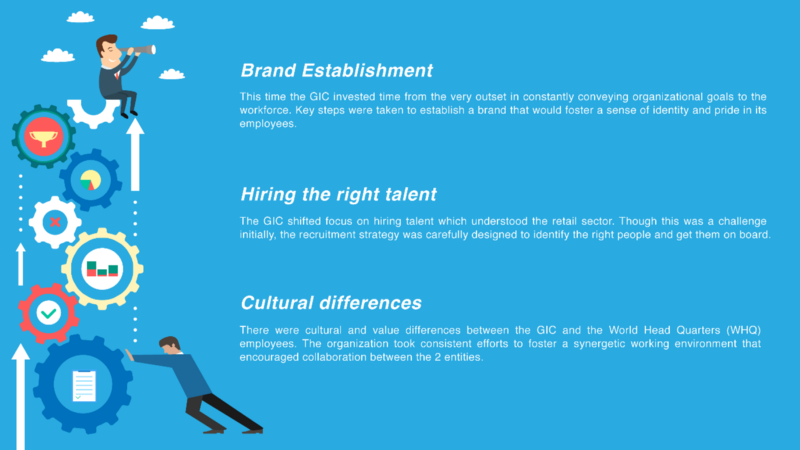|
|
Economic considerations have consistently driven large organizations to outsource Information Technology to External Service Providers. This trend, which saw a rapid growth over the past 2 decades, has recently seen stagnation. A significant number of global leaders across industries soon recognized that outsourcing a majority to all their IT operations could adversely affect the health of the overall business down the line. This led them to reanalyze their portfolios and build a more holistic framework which had a substantial share of insourcing models.
 The growth of the Indian retail GIC story
The growth of the Indian retail GIC story
Let us take the example of this British multinational grocery and general merchandise retailer headquartered in United Kingdom. The HQ initially had a 100% outsourced model, but soon realized the value of insourcing critical business operations and empowering Global In-House Centers (GICs) to deliver consistently.
There are 2 ways by which most businesses transition from an outsourcing to an insourcing model. One is typically a knee jerk reaction to a bad outsourcing relationship- where the organization feels the immediate effects of poor quality and lack of control. Another, is a more gradual strategy of learning from the partnership with the external vendor, and using these lessons to build a strong and robust insourcing model.
The Global Merchandise Retailer in question had a combination of both. The HQ had mainly outsourced work related to routine maintenance and programming. It faced several challenges with the outsourcing relationship that included-
 Key challenges with the outsourcing model
Key challenges with the outsourcing model
While the HQ was still grappling with most of these issues, the turning point occurred when an Indian IT vendor botched up their ecommerce project. Observations made over time about the inefficiency of outsourcing in combination with this event ultimately led the HQ to go back to the drawing board and restructure its operating model.
A key decision born out of this effort was to insource the entire project- which was subsequently delivered with a 20–30% outsourced staff operating on premise, and under direct company management. The model worked and the organization never went back to outsourcing an IT project after this point.
The outsourcing model might have failed in some aspects but still provided some valuable learnings to the UK based retail giant. The leadership used these lessons to put together a plan to leverage the IT Infrastructure and highly skilled talent pool in Bengaluru, India to drive most of their IT operations.
Thus, the Bengaluru GIC was set up in May 2004 to enable standardization and build centralized capabilities and competencies, which would be leveraged across the global business.
The organization faced the same set of challenges that they faced during the outsourcing relationship. However, key lessons from the failure of the relationship enabled them to identify problems areas faster and build solutions more efficiently. Some of the critical road blocks they identified were with regards to:
 Critical roadblocks encountered during GIC setup
Critical roadblocks encountered during GIC setup
The GIC was initially established to provide assistance with backend work such as accounting and customer support. Over time, the scope for creating value with high impact work was recognized and the focus shifted towards empowering GICs to contribute to the overall retail value chain of the organization.
In 2007, the Bengaluru GIC unveiled its first retail test lab in India. The lab would replicate the entire point-of-sale testing infrastructure that is currently available in the UK for testing and certifying all the software that goes into an estate of 1500-plus stores in the UK and the Republic of Ireland (ROI). Employees at the Bengaluru center got a first-hand view of how the Global Retailer runs day to day business and the challenges faced by them. This not only built a brand identity for the newly formed workforce, but also drove home the importance of ownership.
The culture established at the GIC subsequently enabled multiple innovations. The Indian team helped launch an entire digital loyalty scheme for the US. They also built a crack team to capture the growing online retail market and to improve supply chain efficiencies.
Currently, the India center is driving a broad spectrum of work consisting of retail technology, finance, commercial & supply chain, and property services.
Over 70% of the technology team is based out of Bengaluru. This 5,000-strong team plays a pivotal role in driving in revenue for the global business and creating value for its customers. It has been the poster child for constant innovation and out of the box ideas that have moved it up the value chain.
Some key innovations in the recent past have been in the areas of emerging technologies. One such area is that of digitization. The India team, recognizing the global movement towards building digital businesses, undertook the following initiatives:
The organization also drove ownership in the GIC by enabling the team to add strategic value to the retail chain. This led to:
The initial growth pains were mostly related to the culture and identity of the India GIC. This required leadership that could effectively convey the vision of the GIC to the workforce as well as drive efficiency and innovation top down.
The Global Merchandise Retailer invested in the development of leaders in the market who have significantly accelerated the value chain of the center.
The insourcing model is still in the nascent stages as compared to the more mature outsourcing model. However, the organization’s case study is proof that taking a chance on empowering GICs can have significant pay offs.
Non-commodity services that directly or indirectly drive a competitive advantage on the market should be considered for insourcing. Specific to the retail sector, a robust insourcing model can help drive key strategic models and customer focused initiatives in diverse regions. The model also ensures a workforce that is motivated to perform towards achieving organizational goals, and sets a culture that can be driven across other global teams.
Contributors: Manu Jain and Manu Srivastava contributed to the article.